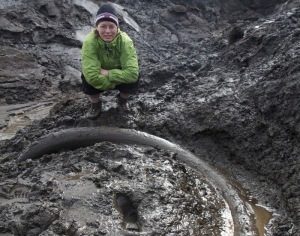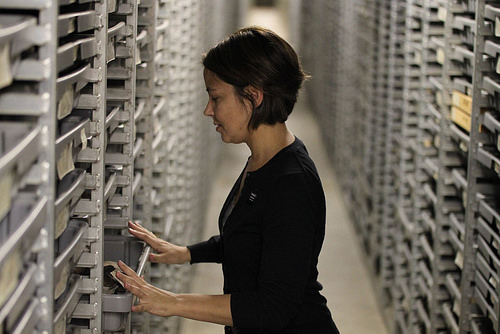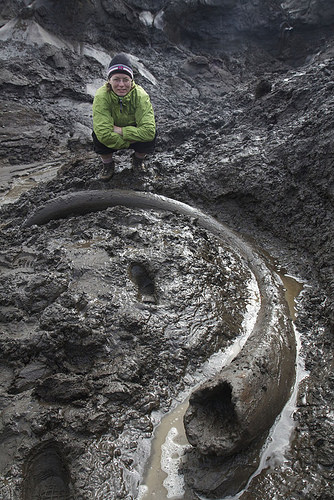
Recent stories appearing in scientific journals and the public media have informed us of some remarkable developments in the science of genetics as it relates to better understanding our past. Just a few of many examples:
— The most complete sequence to date of the Neanderthal genome, using DNA extracted from a woman’s toe bone that dates back 50,000 years, revealed a long history of interbreeding among at least four different types of early humans living in Europe and Asia tens of thousands of years ago;
— Researchers at the Max Planck Institute for Evolutionary Anthropology in Leipzig, Germany, successfully sequenced a complete mitochondrial (mtDNA) genome of a 400,000-year-old representative of the genus Homo (ancient human) from Sima de los Huesos, a cave site in northern Spain that has yielded some of the earliest fossil specimens of humans in present-day Europe. They found that the individual was related to Denisovans, extinct relatives of Neanderthals in Asia, through a common ancestor; and
— The results of a recent study of canine genomes has suggested that dogs and their wolf cousins shared an evolutionary history that is considerably more complex than previously thought, pointing to a common ancestor that lived between 11,000 and 34,000 years ago, and that the earliest dogs may have first lived among hunter-gatherer societies, before the advent of agriculture.
To date, scientists have excavated an untold number of fossil bones, from both animals and their human subset, with the hope that ancient remnants of DNA might somehow be found more or less intact within the fossilized bones. They believe that DNA will be a major key to reconstructing the picture of where we and other animals came from, and how. Now, thanks to advances in DNA extraction and the establishment and growth of DNA libraries of information, scientists are gaining an increasing ability to sequence genomes, a key aspect of the emerging new science of paleogenomics, or the study of ancient DNA. In a Review article published in the journal Science, authors B. Shapiro and M. Hofreiter relate how scientific investigation of the animal world’s physical past is evolving from one that emphasizes excavation to one that includes DNA sequencing as a major component of research. They discuss the successes and advancements as well as the limitations, and suggest that the use of paleogenomics will continue to expand.
_________________________________________________________________________________________
Samples collected from the La Brea tarpits in Los Angeles, CA, have long been targets of paleogenomic analysis. However, despite their incredibly good physical preservation, these bones have proven difficult to use in genetic research, because the tar cannot be completely removed from the bones. Recent advances in techniques for ancient DNA extraction may make bones such as those from La Brea possible targets for paleogenomic analysis, dramatically increasing the range of species that can be analyzed. [Courtesy of Mathias Stiller]
_________________________________________________________________________________________
Scientists working in the Klondike gold fields near Dawson City, Yukon Territory, uncover thousands of bones, tusks, and teeth representing the preserved remains of the ice age megafauna. Here (left), Jana Morehouse crouches behind a frozen mammoth tusk that was exposed as part of placer mining activities. Remains such as these are used in paleogenomic analyses to understand processes including genome evolution and how populations respond to climate change over the short and medium term. [Courtesy of Tyler Kuhn]
________________________________________
The article appears in the 24 January 2014 issue of Science, published by the American Association for the Advancement of Science (AAAS), a nonprofit science society.
____________________________________________________________________________________________
Read about the most fascinating discoveries with a premium subscription to Popular Archaeology Magazine. Find out what Popular Archaeology Magazine is all about. AND MORE:
 On the go? Purchase the mobile version of the current issue of Popular Archaeology Magazine here for only $2.99.
On the go? Purchase the mobile version of the current issue of Popular Archaeology Magazine here for only $2.99.
And, Popular Archaeology’s annual Discovery edition is a selection of the best stories published in Popular Archaeology Magazine in past issues, with an emphasis on some of the most significant, groundbreaking, or fascinating discoveries in the fields of archaeology and paleoanthropology and related fields. At least some of the articles have been updated or revised specifically for the Discovery edition. We can confidently say that there is no other single issue of an archaeology-related magazine, paper print or online, that contains as much major feature article content as this one. The latest issue, volume 2, has just been released. Go to the Discovery edition page for more information.
Subscription Price: A very affordable $5.75 for those who are not already premium subscribers of Popular Archaeology Magazine (It is FREE for premium subscribers to Popular Archaeology). Premium subscribers should email [email protected] and request the special coupon code. Or, for the e-Book version, it can be purchased for only $3.99 at Amazon.com.







